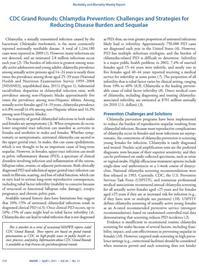This report discusses the sexually transmitted disease (STD), chlamydia, which is common among sexually active adolescents and young adults. It explains that although chlamydia may be asymptomatic, it can have serious consequences in females, including infertility; hence, the importance of chlamydia prevention. Screening females aged <25 years is ranked by the National Commission on Prevention Priorities as one of the 10 most beneficial and cost-effective prevention services, but it also is one of the most underutilized. Behavioral risk reduction such as promoting correct and consistent condom use can have an impact on chlamydia, other STDs, and on unintended pregnancy. It is suggested that screening coverage be increased; partner services, including expedited partner therapy (EPT), should be enhanced; infected individuals should be rescreened after three months of treatment; and efforts should focus on addressing racial/ethnic disparities in chlamydia prevalence. Improvement in measurement of program implementation and outcomes is also suggested.
Format:
Report
Publication Date:
2011
ID:
34866
- STI
- Chlamydia


